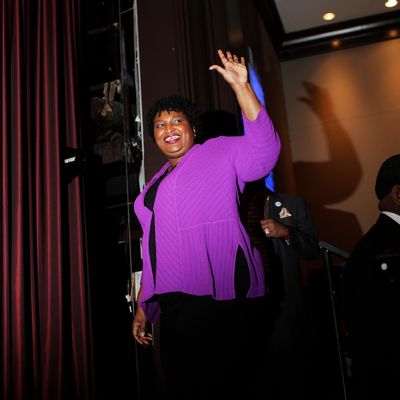
In declining to bend to pressure from Chuck Schumer and others to declare for a 2020 Senate race in Georgia, Stacey Abrams indicated last week that she hadn’t ruled out a presidential run and could announce one as last as September. That probably came as news to the 18 candidates already in the field.
FiveThirtyEight’s Geoffrey Skelley took a stroll down memory lane and looked at the announcement dates of every non-incumbent major-party presidential nominee since 1976, and concluded Abrams might want to accelerate her timetable.
The shortest time between a nominee’s campaign start date and the Iowa caucuses came in 1992 — Democrat Bill Clinton announced the formation of an exploratory campaign on Aug. 15, 1991, just 179 days before the caucuses. But that cycle started late because President George H.W. Bush was so popular in the aftermath of the Gulf War that many potential Democratic candidates waited before declaring their candidacies. Next is Republican Mitt Romney, who announced an exploratory committee on April 11, 2011, only 267 days before the caucuses. In presidential elections since 1976, the non-incumbent presidential nominee who got the earliest start was Democrat John Kerry. On Dec. 1, 2002, he declared that he would form an exploratory committee — that was 414 days ahead of the Iowa caucuses.
As of today, there are 300 days remaining before the Iowa caucuses, currently scheduled for next February 3 (if the date moves at all, it will probably be earlier). A September launch date for Abrams would be later than that of any of the nominees Skelley considers. And he thinks that’s a real problem:
In 2011, FiveThirtyEight editor-in-chief Nate Silver looked at the consequences of kicking off a campaign late and found that late starters struggled, perhaps more than we’d expect otherwise. For example, late entrants sometimes had insufficient time to organize in early caucus states such as Iowa or had trouble raising money.
There have, however, been some late-blooming candidacies that failed to win for reasons other than a late start. Most recently, in the 2012 contest Rick Perry waited until mid-August of 2011 to announce, and within days was looking like he was going to roar past Mitt Romney and win the whole thing. He later faded, but that was mostly because he stumbled and mumbled his way through some disastrous debate performances. That’s very unlikely to happen to Stacey Abrams, who is extremely good on her feet.
Going back a good ways, in 1980 Ted Kennedy announced his intraparty challenge to incumbent president Jimmy Carter on November 8, 1979. He was hurt right off the bat by a famous pre-announcement interview with CBS reporter Roger Mudd in which he was as incoherent as Rick Perry. But he lost mostly because Carter skillfully used the tools of the presidency against him. The same was true of Gerald Ford in 1976; his win had little if anything to do with the “late start” of primary challenger Ronald Reagan, who announced his candidacy on November 20, 1975.
Now it’s true that Kennedy and Reagan had unusually high name recognition going into their late-breaking races; while Abrams has quickly acquired national political celebrity status, she’s not at a Kennedy/Reagan level just yet. To make an autumn candidacy viable, she’d need some major breaks, like a major candidate or two stumbling badly, and no one successfully using the summer debates (which Abrams would miss) to build a commanding lead.
But hey, it’s her career, and unless it’s assumed she’s bluffing, as a potential candidate she remains a real threat to others already in the race–particularly fellow African-Americans Kamala Harris and Cory Booker, neither of whom is likely to beat her in the pivotal early primary in next-door South Carolina. Besides, there’s a lot of attention-grabbing things one can do without being formally announced as a candidate. And Stacey Abrams is quite skillful at grabbing attention, in a good way.






























